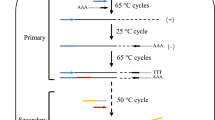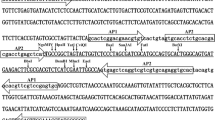Abstract
Several polymerase chain reaction (PCR)-based methods are available for isolation of unknown genomic fragments. In the present study, a comparative evaluation of a few methods of ligation-mediated PCR methods and a ligation-independent one were made by isolating promoter fragment for N-methyltransferase gene involved in the caffeine biosynthetic pathway of Coffea canephora. The benefits of tertiary PCR and the effects of a 4-base cutting restriction endonuclease on the size of the PCR products obtained were demonstrated in one of the ligation-mediated PCR methods. The methods adopted in this study differed in the sizes of the 5'-flanking regions obtained. The efficiencies of various methods used reflect the inherent limitations of the PCR-based methods for isolation of unknown flanking regions.
Similar content being viewed by others
References
Sambrook, J., Fritsch, E. F., and Maniatis, T. (1989) Molecular Cloning: a laboratory manual. 2nd ed., Cold Spring Harbor Press, Cold Spring Harbor, NY.
Saiki, R. K., Gelfand, D. H., Stoffel, S., Scharf, S. J., Higuchi, R., Horn, G. T., Mullis, K. B., and Erlich, H. A. (1988) Primer-directed enzymatic amplification of DNA with a thermostable DNA polymerase. Science 239, 487–491.
Nthangeni, M. B., Ramagoma, F., Tlou, M. G., and Litthauer, D. (2005) Development of a versatile cassette for directional genome walking using cassette ligation-mediated PCR and its application in the cloning of complete lipolytic genes from Bacillus species. J. Microbiol. Methods 61, 225–234.
Ochman H., Gerber, A. S., and Hartl, D. L. (1988) Genetic applications of an inverse polymerase chain reaction. Genetics 120, 621–623.
Rosenthal, A. and Jones, D. S. (1990) Genomic walking and sequencing by oligo-cassette mediated polymerase chain reaction. Nucleic Acids Res. 18, 3095–3096.
Kilstrup, M. and Kristiansen, K. N. (2000) Rapid genome walking: a simplified oligo-cassette mediated polymerase chain reaction using a single genome-specific primer. Nucleic Acids Res. 28, e55.
Lagerstrom, M., Parik, J., Malmgren H., Stewart, J., Pettersson, U., and Landegren U. (1991) Capture PCR: efficient amplification of DNA fragments adjacent to a known sequence in human and YAC DNA. PCR Methods Appl. 1, 111–119.
Siebert, P. D., Chenchik, A., Kellogg, D. E., Lukyanov, K. A., and Lukyanov, S. A. (1995) An improved method for walking in uncloned genomic DNA. Nucleic Acids Res. 23, 1087–1088.
Padegimas, L. S., and Reichert, N. A. (1998) Adapter ligation-based polymerase chain reaction-mediated walking. Anal. Biochem. 260, 149–153.
Cormack, R. S. and Somssich, I. E. (1997) Rapid amplification of genomic ends (RAGE) as a simple method to clone flanking genomic DNA. Gene 194, 273–276.
Liu, X. and Baird, W. V. (2001) Rapid Amplification of Genomic DNA Ends by NlaIII partial digestion and polynucleotide tailing. Plant Mol. Biol. Rep. 19, 261–267.
Liu Y. G. and Whittier, R. F. (1995) Thermal asymmetric interlaced PCR: Automatable amplification and sequencing of insert and fragments from P1 and YAC clones for chromosome walking. Genomics 25, 674–681.
Chen, X. and Ray, W. (1997) Direct amplification of unknown genes and fragments by Uneven polymerase chain reaction. Gene 185, 195–199.
Satyanarayana, K. V., Vinod, K., Chandrashekar, A., and Ravishankar, G.A. (2005) Isolation of promoter for N-methyltransferase gene associated with caffeine biosynthesis in Coffea canephora. J. Biotech. 119, 20–25.
Lukyanov, S. A., Gurskaya, N. G., Lukyanov, K. A., Tarabykin, V. S., and Sverdlov, E. D. (1994) Highly efficient subtractive hybridization of cDNA. Bioorg. Chem. 20, 701–704.
Author information
Authors and Affiliations
Corresponding author
Rights and permissions
About this article
Cite this article
Satyanarayana, K.V., Chandrashekar, A. & Ravishankar, G.A. Evaluation of PCR-based methods for isolating flanking regions of genes. Mol Biotechnol 32, 111–116 (2006). https://doi.org/10.1385/MB:32:2:111
Issue Date:
DOI: https://doi.org/10.1385/MB:32:2:111




